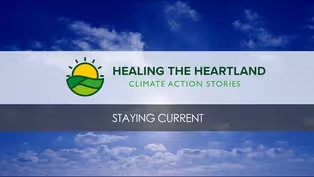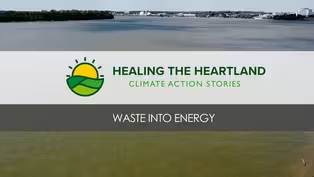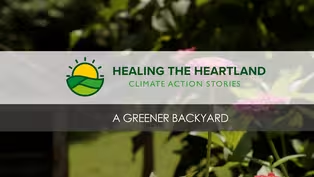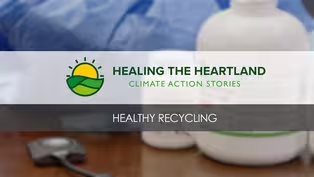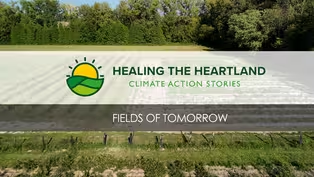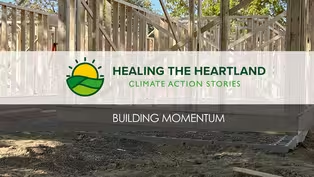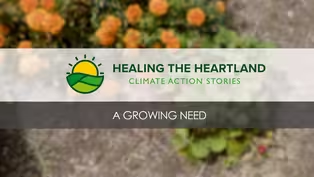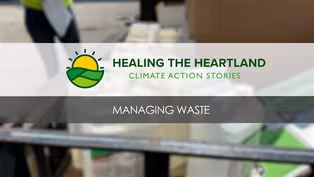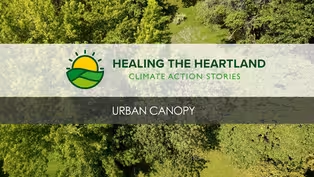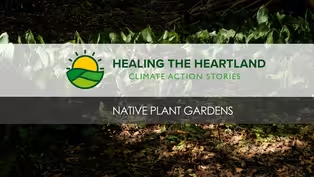Healing the Heartland: Climate Action Stories
Native Plant Gardens
Clip | 4m 22sVideo has Closed Captions
Native plants combat climate change.
Native plants combat climate change and the loss of biodiversity; they build carbon stores underground with their deep root systems and offer bees and other pollinators food that is adapted to our area, all while requiring less resources compared to other popular garden plants.
Problems playing video? | Closed Captioning Feedback
Problems playing video? | Closed Captioning Feedback
Healing the Heartland: Climate Action Stories is a local public television program presented by WNIN PBS
Healing the Heartland: Climate Action Stories
Native Plant Gardens
Clip | 4m 22sVideo has Closed Captions
Native plants combat climate change and the loss of biodiversity; they build carbon stores underground with their deep root systems and offer bees and other pollinators food that is adapted to our area, all while requiring less resources compared to other popular garden plants.
Problems playing video? | Closed Captioning Feedback
How to Watch Healing the Heartland: Climate Action Stories
Healing the Heartland: Climate Action Stories is available to stream on pbs.org and the free PBS App, available on iPhone, Apple TV, Android TV, Android smartphones, Amazon Fire TV, Amazon Fire Tablet, Roku, Samsung Smart TV, and Vizio.
I think with the younger generation, climate change maybe not on the forefront of a lot of their minds.
I know they see it online.
You know, they see it in the news, but they not they might not think about it day in and day out.
So I believe like initiatives that are workable, like having native plant gardens, for instance, is a great way to get them involved with, with the issue.
So the first step was to plant a native plant garden, here on campus, which you see behind us, Doctor Edie Hardcastle working with some students on an endeavor grant.
So a little bit of education, bringing the students into the mix, into a public space was our first step.
So we're here in the Experimental Pollination Garden at USI, and this is part of the bigger project, to establish USI as a bee campus.
So Bee Campus USA, is an organization that USI chose to align ourselves with.
They're an initiative of the Xerces Society.
And what they do.
And their main mission is pretty much the same thing we have, which is to spread information about native plant gardens and pollinators.
And so bee campus is just a nice way of saying pollinator friendly, because we're not going to limit ourselves to bees.
we've got biologists here interested in every species, birds and plants and moths and butterflies and fish.
And so it all works together.
Climate change is is one thing that we're certainly concerned about, but something that goes hand in hand with climate change is, is how biodiversity is decreasing, you know, throughout the world.
And so planting native plants is a way to help combat some of that loss of biodiversity, both by planting the plants themselves and giving them a space to to flourish, but also by all the different insects and other upper trophic levels within the community.
That's that it's helping to attract also, then beyond that, just the plants themselves, the native plants, compared with a lot of the other typical garden plants, have a lot deeper roots, than than a lot of plants that most people think about when they plant a garden.
And so all that deep root system is a great source of carbon sequestration.
You're building up these, these carbon stores underground with these really deep roots.
And at the same time, it's also reducing the amount of resources you need to maintain these native plants, you know, to maintain typical garden plants or a lawn very resource intensive, which can be a strain.
you know, maybe require even the use of fossil fuels, water, etc..
These native plants are adapted for this area, and so they're going to require minimal maintenance and therefore save us a lot of resources just by filling the space with them.
and we have, folks that are coordinating on this, not only other professors at USI, but part of the the grounds crew at USI, students that are doing research on this issue at USI.
the other, collaborators that I've been working with are at University of Evansville.
They're actually a little bit ahead of us.
This whole research question centers on what are the benefits humans get from having nature.
And in urban society, we kind of forget that nature exists.
And one of the things that a lot of folks in Evansville are investing in are bringing plants, native plants into their backyard.
And by doing that, they're providing food sources for pollinators.
And those pollinators then can also be pollinating gardens and providing resources that allow our fruits in our gardens to set.
And so get a harvest of apples or cherries or eggplants or tomatoes.
And so this research is demonstrating how important those native bees are, and specifically how important bumblebees are.
So the native plant garden is not supposed to be like a one off, one and done project.
It's supposed to be an example.
So having small populations of plants, I'll be honest, doesn't do a lot.
But when you can spread those populations across many yards, across many towns, it has a major impact.
So we think by showing these plants off and showing you what can be done as an alternative to traditional gardening, we're hoping to get more people to hop on board with us.
Clip | 3m 44s | Solar systems can be energy and cost efficient for residential and commercial buildings. (3m 44s)
Clip | 4m 19s | Both personal and mass transit electric vehicles greatly reduce greenhouse gas emissions. (4m 19s)
Video has Closed Captions
Clip | 3m 8s | Mesker Park Zoo and the Evansville Water Sewer Utility describe how they turn waste into energy. (3m 8s)
Video has Closed Captions
Clip | 3m 59s | Using native plants to have a lower impact on the environment. (3m 59s)
Video has Closed Captions
Clip | 3m 7s | A partnership between Berry Plastics and Deaconess Health helps reduce medical waste. (3m 7s)
Video has Closed Captions
Clip | 4m 35s | Sustainable farming practices and innovations. (4m 35s)
Video has Closed Captions
Clip | 3m 8s | Affordable, energy efficient housing program and affordable, restorative housing program. (3m 8s)
Video has Closed Captions
Clip | 3m 20s | How choosing local food and reducing food waste can help with climate change. (3m 20s)
Video has Closed Captions
Clip | 3m 31s | Local faith groups talk about the importance of environmental stewardship. (3m 31s)
Video has Closed Captions
Clip | 3m 10s | Dubois County Ag Day featuring plastic, tire, and pesticide container recycling programs. (3m 10s)
Video has Closed Captions
Clip | 4m 29s | Learn about the importance of an urban canopy. (4m 29s)
Video has Closed Captions
Clip | 4m 22s | Native plants combat climate change. (4m 22s)
Providing Support for PBS.org
Learn Moreabout PBS online sponsorship
- Science and Nature

Explore scientific discoveries on television's most acclaimed science documentary series.

- Science and Nature

Capturing the splendor of the natural world, from the African plains to the Antarctic ice.












Support for PBS provided by:
Healing the Heartland: Climate Action Stories is a local public television program presented by WNIN PBS
